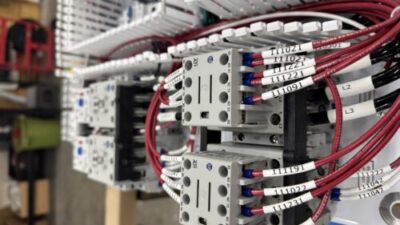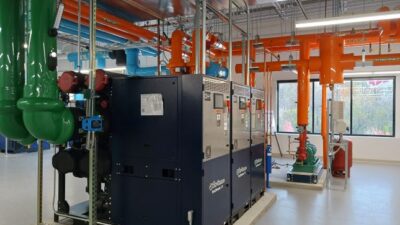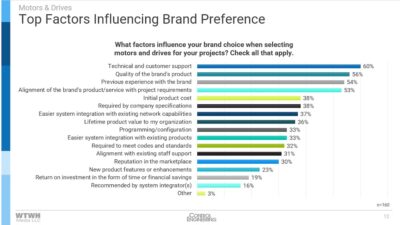Engineers voice their opinions in a Control Engineering-Molex Inc. survey about the criticality of harsh duty cabling and connectors as they relate to production failures, equipment downtime, and industrial network connectivity.
|
Most of these respondents (48%) handle the purchase of cable and connectors for use on all equipment within their purview.
|
|
Cables and connectors are an integral feature of any technology, consumer or industrial. Whether they are being used to connect the internal components of capital equipment, or connecting a separate piece of equipment into a larger system array, their use is unavoidable. Typically, such integral technologies are often the main topic of conversation in the industries in which they typically are used. Cables and connectors, however, have more often been relegated to utilitarian points of discussion.
Though cables and connectors may never be viewed as being as sexy as the newest industrial computing and networking technologies, three major issues across manufacturing are working to bring cables and connectors increasingly into the limelight. Those issues are:
-
Equipment suitability to different environments as manufacturers diversify their production processes;
-
Efforts to further reduce equipment downtime to avoid unnecessary repair costs; and
-
Increasing levels of equipment connectivity to enterprise networks to deliver real-time production data.
Cross-industry insight
To better understand the realities impacting the decisions around the purchase and use of cables and connectors in the current manufacturing environment, Control Engineering and Molex partnered to collect insight from end-users, OEMs (equipment manufacturers), engineering consultants, and system integrators. The survey, conducted in early December 2009, received nearly 300 responses providing an array of response from a variety of manufacturing industries.
The largest groupings of respondents came from the capital equipment/machinery/OEM (23%), electronics (11%), metals and mining (10%), food and beverage (8%), chemicals (7%), automotive (7%), and petrochemical (7%) manufacturing industries.
|
Regardless of manufacturing application, if the environment is harsh, the importance of selecting suitable cabling and connectors is a critical factor to production uptime.
|
Principal respondents were end users, providing 48% of responses. OEMs (25%), engineering consultants (15%), and system integrators (12%) represented the remaining survey respondents. Most of these respondents (48%) handle the purchase of cable and connectors for use on all equipment within their purview. Only 18% had never directly purchased such products. Nearly all respondents (80%) work in harsh environment production areas and 80% said that they had experienced equipment downtime as a direct result of harsh environment conditions.
In those cases where equipment downtime was encountered due to harsh environment, 21% of respondents indicated that the cause was due to cabling/connector issues. Though the majority of downtime experienced was due to equipment failures (61%), cabling was the number two cause of downtime—nearly double the amount of maintenance issues and more than three times as much as network failures.
The clear message delivered by responses to this portion of the survey is that, regardless of manufacturing industry application, if the environment is harsh, the importance of selecting suitable cabling and connectors is a critical factor to production uptime.
|
Nearly 80% of respondents at least "sometimes" connect harsh duty equipment to an enterprise network.
|
Networking concerns
A number of respondents took the opportunity provided by the survey to note their use of harsh duty Ethernet cabling and connectors. Following are comments from two respondents:
“We changed our entire enterprise network over to an Ethernet control network that is owned by engineering, not IT. We are using harsh duty cabling and harsh duty industrial Ethernet switches.”
“[We are] experimenting with industrial Ethernet cabling (hardened connectors with positive connector locks).”
These comments related to Ethernet and its most common RJ-45 connection mark some of the most recent harsh duty cabling and connection issues to be faced by manufacturers. Whether it’s mandated by corporate and supply chain directives to gather more real-time capable-to-promise/deliver data or part of an initiative to collect more plant floor-related OEE (overall equipment effectiveness) and production metrics, the fact is that more and more plant floor equipment is being connected to the manufacturing enterprise network. In addition, as Ethernet continues to prove its suitability in industrial networking environments, the wide familiarity Ethernet technology enjoys among engineers and IT professionals only helps to fuel its broader use and acceptance.
Survey data reveals that only 23% of respondents “never” connect equipment in harsh duty areas to the enterprise network. Considering that less than 10 years ago many engineers were still suspect about Ethernet’s suitability for industrial use, to find that nearly 80% of respondents now at least “sometimes” connect harsh duty equipment to an enterprise network spotlights a major shift in industrial networking technology attitudes and application. It also serves to elevate the importance of cables and connectors in the wider industrial equipment discussion.
Yet the data from the survey still shows a great deal of education on the importance of proper cabling and connector decisions is needed. Only 30% of respondents believe that the harsh environment in which they operate is a “critical” factor in their network connection choices. A nearly identical percentage claims it has “no” impact on their decision.
|
With more control equipment moving out of the cabinet, a clear disconnet remains between users’ perspectives on the impact the environment has on their cabling and reality.
|
OEM and user perspectives
An additional component to this joint Control Engineering -Molex project involved interviewing attendees at the 2009 SPS/IPC/Drives show held in Nuremberg, Germany, in November 2009. Attendees were asked about their preferences related to cable/connector specifications on equipment used in harsh duty areas and about the trends they see impacting these technologies.
As both an OEM and end-user of industrial equipment in harsh environments, Marc-Christian Witt, managing director of Witt Elektronik in Neuhausen, Germany, said that when Witt Elektronik purchases capital equipment for production use, they appreciate when the proper cabling is provided by the equipment producer. He added that Witt Elektronik also works to provide the right cabling on the equipment it produces for customers based on application.
Speaking from a contract manufacturer and system integrator perspective, Thomas Dosch, distribution sales manager for Lacon in Karlsfeld, Germany, concurred with Witt, saying that he would prefer the cabling Lacon uses for projects to be specified by a cabling expert for the application. “In this way, we receive the cabling tested and certified and it is easier for us to implement it,” he said.
Andreas Vogt, vice president of engineering for Molex, noted that he is familiar with the preferences Witt and Dosch expressed and added that Molex sees customers’ cabling and connector specification preferences varying, depending on the size of company. “The bigger customers definitely prefer to do the specifications themselves,” Vogt said. “The smaller customers expect us to be the provider of the solution, as they tend to be looking for someone to solve their problem rather than just provide cables and connectors.”
In terms of trends, Witt said that he sees the fast-growing alternative energy industries having a big impact on the development and use of harsh duty cables and connectors. In the near-term, Witt said he expects to see more specifications related to cabling coming from customers in the wind and solar energy industries.
Elisabeth Eckstein, a purchaser for LTN Servotechnik in Otterfing, Germany, also commented on interest LTN is seeing for harsh duty cables and connectors from the new energy sectors, wind energy in particular. “We currently have a project ongoing in wind power, for which we have specified the appropriate cabling and connectors because the slip ring has to operate in the extreme environments (to which wind turbines are exposed).”
Vogt added that, overall, he is seeing more and more control “moving out of the cabinet” and is therefore bringing cables, connectors, and distribution blocks more directly into harsh duty environments.
| Author Information |
| Reach David Greenfield, editorial director, at [email protected] |
Application comments
Several respondents to the joint Control Engineering -Molex harsh duty cabling and connectors survey provided examples of how and where they are using harsh duty cabling and connectors to address specific equipment reliability issues in the environment in which the equipment operates. Following are a few of the verbatim comments received from respondents:
-
“[We need] connectors suitable for use in a weak chlorine vapor atmosphere (fumes from 12% bleach solution). This causes long-term degradation of exposed metals, such as connectors, in the electrical equipment.”
-
“We use all kinds of sensors in an acidic, caustic and heavily washed down environment. Most of the wiring is protected by rigid conduit, but at the final connection point, wire is exposed and we use NEMA 4X type connectors.”
-
“We need to accomplish standards related to Div I Class II, and sometimes the corrosion issues could cause failures on devices connected on it.”
-
“[We build] sub-sea equipment [used in depths up] to 6,000 m depth. [This involves] connecting video (both coaxial and fiber optic), Ethernet, twisted pair, and high voltage [cables running up] to 4600 V ac and 6000 V dc.”
-
“Dust metal shavings and conductive debris gets in connectors.”
-
“Chemicals involved with cleaning (CIP systems) require cabinet connectors for cabling suitable for alkaline/acid wash down. All connections are sealed and cabinets pressurized.”
-
“[Cables used in our equipment are] submerged in hydraulic oil between -40 °C and 125 °C and must survive lots of mechanical abuse, abrasion, and bending.”
-
“We connect the Ethernet connections to portable equipment in a heavy washdown environment.”
-
“Safety system [installation] means working in harsh areas requiring IP67 or better on RJ-45 and networks.”



